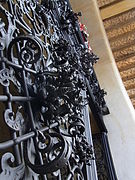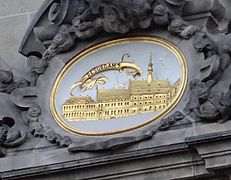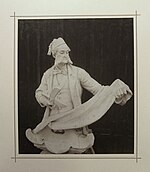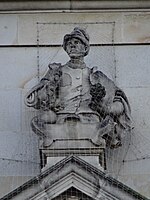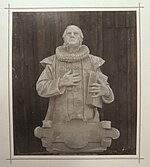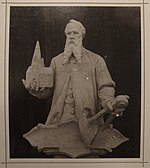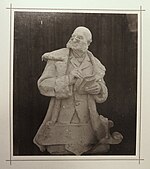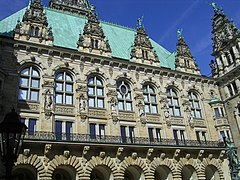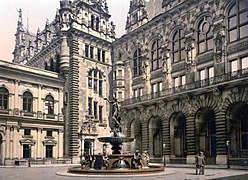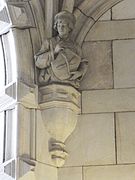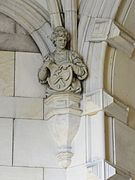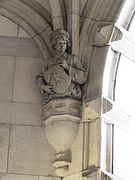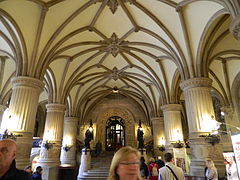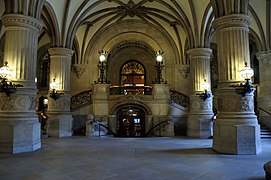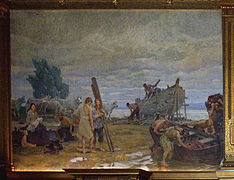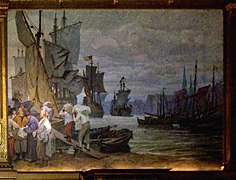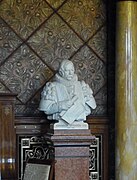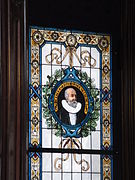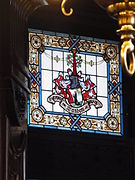Hamburg City Hall
| Hamburg City Hall | |
|---|---|
 |
|
| Data | |
| place | Hamburg |
| builder | Johannes Grotjan , Martin Haller , Bernhard Hanssen , Wilhelm Hauers , Leopold Lamprecht, Wilhelm Meerwein , Henry Robertson, Hugo Stammann , Gustav Zinnow |
| Construction year | 1886 to 1897 |
| height | 112 m |
| Floor space | 7,840 m² |
| Coordinates | 53 ° 33 '1 " N , 9 ° 59' 32" E |
| particularities | |
| Seat of the citizenship and the Senate of the Free and Hanseatic City of Hamburg | |

The Hamburg City Hall is the seat of the Hamburg Parliament and the Senate of the Free and Hanseatic City of Hamburg . The architecturally magnificent building on the Kleine Alster was built from 1886 to 1897 in the historicist style of the neo-renaissance . The tower is 112 meters high and, along with the towers of Hamburg's main churches, is an important landmark in the Hamburg cityscape.
history
The predecessors
Today's town hall is probably the sixth town hall in the history of the town. The first two were probably in the new town on the Hopfenmarkt and in the archbishop's old town on the Old Fish Market . After the unification of the two cities in 1216, a common town hall was built on the Kleine Johannisstraße at the corner of Dornbusch . A fire in 1284 destroyed all houses and probably also the town hall. Only the vaulted cellar was preserved and served as a council wine cellar and wine store. The building erected on it was later named Eimbeck'sches Haus , as it was the only one with a license for Einbecker beer. Half of the Ratsweinkeller collapsed in the Great Fire in 1842 . A recovered Bacchus figure still stands in the town hall on the stairs leading to the Ratsweinkeller at the entrance to Große Johannisstraße.
Around 1290 a larger town hall was built on Neß on the Trostbrücke . The brick building , which was built on an area of 26 meters by 17 meters with a two-storey hall, was gradually expanded. The Lower Court was added and a Renaissance extension at the beginning of the 17th century . In 1619 the Hamburg bank moved in . This ensemble of buildings in the vicinity of the old Hamburg Stock Exchange formed the political and economic center of Hamburg for several centuries.
Provisional arrangements after the great fire
During the great fire of 1842, the old town hall at the Trostbrücke was blown up to create a firebreak and stop the fire. However, the detonation was incomplete and the flames, which found sufficient food in the rubble, were able to spread further over the aisle. Some of the statues of German emperors that were inserted on the facade of this town hall since 1640 have been preserved and can now be seen on the outer facade of the Museum of Hamburg History . Silver bars from the silver treasure fused with fire rubble are also on display in the Phoenix Hall of the town hall.
In 1842 the orphanage on Admiralitätsstrasse , built in 1785 and destroyed in World War II, became the provisional town hall. A memorial plaque and a portal arch on site have been preserved. The citizenship and the constituent assembly of the city of Hamburg met temporarily until the completion of the new town hall in the great hall of the Patriotic Society , whose house was built in 1847 on the site of the old, destroyed town hall.
Planning and construction of today's town hall


A place on the small Alster at the rear of the new stock exchange was chosen as the location of the new town hall , which was the only building in this area to be saved from the fire. However, the realization of construction took 43 years from the first competition designs 1854 (43 designs) and 1876 (128 drafts) on the final adoption in 1884 until completion in 1897. The foundation of the town hall is due to the soil conditions on more than 4000 oak piles founded .
The project was initially slowed by the priority rebuilding of the city, including the political upheavals of the revolution of 1848/49 , the economic crisis of 1857 , the clashes between the great powers up to the establishment of the empire in 1870/71 , the construction workers' strike in 1889 and the cholera epidemic of 1892 . Above all, however, the fact that many voices contributed to the design and the building site without making a decision led to long delays.
A large number of well-known architects were represented with designs (e.g. Gottfried Semper , William Lindley , Alexis de Chateauneuf , George Gilbert Scott - winner 1854, Ludwig Bohnstedt , Julius Carl Raschdorff , Mylius & Bluntschli - winner 1876, Otto Wagner ). The concrete planning was finally carried out by a Hamburg architect group, the Rathausbaumeisterbund , under the direction of Martin Haller with his partner Leopold Lamprecht and the architects Bernhard Hanssen , Wilhelm Meerwein , Johannes Grotjan , Wilhelm Hauers , Hugo Stammann , Gustav Zinnow , Henry Robertson, those without Commissioned in 1880 to create the later realized design and to carry it out from 1886.
“Allow me to say a few words about the exterior of the building. The main building is carried out uniformly in the German Renaissance style. The increase in the number of axles, which gradually emerged from inner space requirements, and the second upper storey added later for the same consideration, give the facade a predominantly vertical division and thus a harmony with the rising tower, which our original plan missed. [...]
The rich bronze and copper figurative decorations, which can hardly be seen in any other building in the world, as well as the stone statues of the courtyard facade and the window crowning of the main floor created by Denoth 's masterly hand remove the monotonous impression, which one so frequent repetition of the same system of facades. The shape of the tower, the product of years of architectural studies, allows the secular building, seen from a distance, to be effectively distinguished from our numerous churches. - That the distant view from the Lombard Bridge suffers from the collapse of the town hall tower with that of the Nicolaikirche is perhaps the only reproach that can be made against those prudent men who see s. Z. designed the beautiful plan to rebuild the city after the great fire. "
facade
The two-wing granite and sandstone building has a 111-meter-wide facade, dominated by a 112-meter-high central tower, the height of which corresponds to the width of the entire building. The roof is covered with copper. The overall effect of the facade is created by the combination of Italian and North German Renaissance elements.
The magnificent black entrance portal with lush tendrils and tangled rosettes and figures is a testament to the artistry of the Hamburg art blacksmith's craft.
The copper spire is crowned by a gilded imperial eagle, its four stone gables are decorated with four knights holding heraldic flags embossed in copper.
The coats of arms of various Hanseatic families are affixed above the ground floor exterior windows .
The phoenix
On the tower shaft between the large tower clock and the coat of arms of Hamburg, the phoenix arbor commemorates the great fire disaster of 1842. Exactly 50 years after the great fire of May 6, 1842, the topping-out ceremony of the “new town hall” was celebrated. The large phoenix figure created by the sculptor Aloys Denoth was dragged to the town hall by four black horses. The fully sculpted phoenix spreads its wings wide to rise newborn out of the fire. A medallion underneath shows the old town hall, which burned down in 1842, with the slogan "RESURGAM" ( Latin for "I will be resurrected") floating above it .
The emperors
On the Rathausmarkt side, between the window niches, there are twenty kings and emperors of the old German Empire , from Charlemagne to Franz II, each weighing 600 kg in bronze. On the central tower, above the monarch, depictions of the civil virtues are enthroned: bravery, piety, harmony and prudence (from left to right) . The fact that the civic virtues are placed above the emperors symbolizes the freedom of the city of Hamburg vis-à-vis the crown, since Hamburg was not an imperial city but a Hanseatic city. There is also a mosaic above the main entrance depicting the Hamburg state allegory of Hammonia .
| Item | Surname | sculptor |
|---|---|---|
| 1 | Lothar III. of Saxony (1125–1137) | Bruno Kruse from Berlin (1892-1893) |
| 2 | Henry III. (1039-1056) | Wilhelm Giesecke from Hamburg (1892-1893) |
| 3 | Conrad II (1024-1039) | Wilhelm Kumm from Berlin (1892-1894) |
| 4th | Otto II (973-983) | Karl Garbers from Dresden (1892-1893) |
| 5 | Otto I. (936-973) | August Vogel from Berlin (1892-1893) |
| 6th | Henry I (919-936) | Friedrich Pfannschmidt from Berlin (1892-1893) |
| 7th | Konrad I. (911-918) | Theodor Richard Thiele from Hamburg (1892) |
| 8th | Ludwig the German (843–876) | Georg Küsthardt from Hildesheim (1892-1893) |
| 9 | Louis the Pious (814–840) | Robert Ockelmann from Dresden (1892-1893) |
| 10 | Charlemagne (768–814) | Joseph von Kramer from Munich (1892-1893) |
| 11 | Friedrich Barbarossa (1152–1190) | August Vogel from Berlin (1893) |
| 12 | Henry VI. (1190–1197) | Engelbert Peiffer from Hamburg (1892-1893) |
| 13 | Frederick II (1212-1250) | Carl Echtermeier from Braunschweig (1892-1893) |
| 14th | Rudolf von Habsburg (1273–1291) | Karl Hilgers from Charlottenburg (1892-1893) |
| 15th | Charles IV (HRR) (1346-1378) | August Herzig from Dresden (1892-1893) |
| 16 | Maximilian I (HRR) (1493-1519) | Joseph von Kramer from Munich (1892-1893) |
| 17th | Charles V (1519–1556) | Jacob Ungerer from Munich (1892-1893) |
| 18th | Maximilian II (1564–1576) | Friedrich Hartzer from Berlin (1892-1893) |
| 19th | Joseph II (1765-1790) | Carl Börner from Hamburg (1892) |
| 20th | Francis II (1792-1806) | Aloys Denoth from Hamburg (1892-1894) |
The chronological order goes from Charlemagne above the main portal to the left via Ludwig the Pious to Lothar III v. Saxony and to the right via Friedrich Barbarossa to Franz II.
The civil professions
Over 28 windows on the representation floor, 28 character busts for representatives of the civil professions were placed on the window canopy.
In these figures, the sculptor Aloys Denoth portrayed well-known personalities of that time. Heinz-Jürgen Brandt shows in his book that this series of figures was lively welcomed by contemporaries as a welcome enlivenment of the facade and as a representation of the bourgeois industry.
The list here begins on Große Johannisstraße and ends on Alten Wall. In accordance with the structure of the town hall, on the town hall market side there is the portrait of the mayor (No. 4) on the left and the mayor (number 21) on the right.
Below are photos of the facade and old photos of Aloys Denoth's plaster models (with minor differences from the final version) .
| job | Remarks | image | Plaster model |
|---|---|---|---|
| Fisherman | |||
| Skipper | |||
| Merchant | |||
| Mayor President | Portrait of Johann Georg Mönckeberg (1839–1908) (with bell and bill in hand) | ||
| cutter | |||
| chimney sweeper | |||
| Shoemaker | Master W. Knieriem from St. Pauli (Lange Straße 18/19) | ||
| Beer brewer or host (with cigar) | |||
| Baker (or confectioner ) | |||
| butcher | |||
| Farmer | |||
| gardener | |||
| sculptor | Portrait of Engelbert Peiffer (1830–1896) (Hamm sculptor's studio, Louisenweg 117) | ||
| Shipbuilders | |||
| locksmith | Portrait of master locksmith Hermann Eggers | ||
| Carpenter | |||
| Bricklayer | |||
| carpenter | Portrait of Julius Rud. Loose (craft workshop, powder pond 11) | ||
| potter | Portrait of ADC Warnstedt, master potter (Harvestehude, Mittelweg 142) | ||
| painter | Portrait of JG Valentin Ruths (1825–1905), landscape painter (Uhlenhorst, Fährstraße 23) | ||
| mayor | Portrait of Carl Friedrich Petersen (1809–1892), Chairman of the Town Hall Commission, with a town hall model in his arms | ||
| engineer | Portrait of chief engineer Franz Andreas Meyer (1837–1901) (with a model of a bridge in his arm) | ||
| Judge | Portrait of court president Ernst Friedrich Sieveking (1836–1909) | ||
| Scholar | Portrait of Justus Brinckmann (1843–1915) with collection objects in his hands (the cup has broken out of the facade) | ||
| Teacher | Portrait of the geographer Prof. Dr. Georg von Neumayer (1826–1909), the director of the German observatory (at that time still at the Stintfang ) | ||
| pastor | |||
| builder | Portrait of the architect Wilhelm Hauers (1836–1905) - with the model of the Church of St. Johannis (Harvestehude) in his arms | ||
| estate agents | Portrait of Eduard Behrens sen. (1824–1895), a banker and art collector |
Roofscape
The crowning figures on the roof are the saints , the patron saints of the Hamburg parishes and, in addition, the two dissolved monasteries that previously existed in the same place where the town hall now stands.
- Katharina for the Katharinenkirche - created by the sculptor Aloys Denoth (Hamburg) (1851–1893) (Rathausmarkt - left)
- Michael for the Michaeliskirche - created by the sculptor August Vogel (Berlin) (1859–1932) (Rathausmarkt right)
- Petrus for the Petrikirche - created by the sculptor Wilhelm Kumm (Berlin) (1861–1939?) (Stock exchange page)
- Jakob for the Jacobi Church - created by the sculptor Engelbert Peiffer (Hamburg) (1830–1896)
- Nikolaus for the Nikolaikirche - created by the sculptor Rudolf Thiele (Hamburg) (1856–1930)
- Paul for the suburb of St. Pauli - created by the sculptor Robert Ockelmann (Dresden) (1859–1915) (west gable)
- Georg for the suburb of St. Georg - created by the sculptor Bruno Kruse (Berlin) (1855–?) (East gable)
- Maria Magdalena for the Maria Magdalena monastery - created by the sculptor Friedrich Offermann (Dresden) (1859–1913)
- Johannes for the Johanniskloster - created by the sculptor Otto Dobbertin (Hamburg) / Friedrich Offermann (Dresden) (1859-1913)
In addition, squires with the coat of arms of the Hanse outposts can be seen on smaller west gables . These are the coats of arms of Bruges , Novgorod , London and Bergen .
Inner courtyard (Ehrenhof)
Together with the stock exchange , which was built in 1841 , the town hall has a magnificent inner courtyard that is accessible to the public from Alten Wall and Grossen-Johannis-Strasse . The inner courtyard with its richly decorated facades in the style of the Italian and North German Renaissance and the central Hygieia fountain is architecturally one of the most demanding and successful squares in the city (see below).
The courtyard is lined with six niche figures at a height of around twelve meters. The figures represent bishops and counts who were important for the history of the city of Hamburg.
- Bishop Ansgar (801–865) - created by the sculptor Arthur Boué (Berlin) (1868–1905)
- Bishop Adaldag (around 900–988) - created by the sculptor Friedrich Everding (Bremen)
- Bishop Adalbert (around 1000–1072) - created by the sculptor Wilhelm Wandschneider (Berlin) (1866–1942)
- Duke Heinrich the Lion (1129–1195) - created by the sculptor Heinrich Möller (Dresden) (1835–1929)
- Count Adolf III. von Schauenburg (1164–1225) - created by the sculptor Robert Ockelmann (Dresden) (1859–1915)
- Count Adolf IV. (1205–1261) - created by the sculptor Carl Friedrich Echtermeyer (Braunschweig) (1845–1910)
Hygieia fountain
In the inner courtyard of the town hall is the Hygieia fountain , designed in 1895/1896 by the sculptor Joseph von Kramer (1841–1908), a brother of Theodor von Kramer . The female bronze figure, the Hygieia , an allegory for health, steps on a dragon, symbolic of the cholera epidemic of 1892 . This fountain also stands for hygiene in practical terms, as the inlets of the town hall's ventilation system are located in its base. Originally, a figure of the merchant god Mercury was planned for the square . After the great cholera epidemic with thousands of deaths, however, it was decided for reasons of piety in favor of the goddess of purity. The figures surrounding the Hygieia represent the benefits and uses of water.
ground floor
A total of 647 rooms are located in the town hall. In addition to rooms for the work of the parliamentary groups and the Senate, the building services, archives and library, the representative halls on the first floor are particularly worth seeing. Like the outer facade, they are provided with allegorical representations in the style of the time and richly decorated as an expression of the civic pride of the city-republic.
Tower hall
From the town hall market one comes through the large wrought-iron entrance gate into the octagonal tower hall made of unplastered, cut sandstone.
The artistic entrance gate, like the gate to the so-called Senate enclosure, was made in the workshop of master locksmith Eduard Schmidt , the first chairman of the Hamburg Chamber of Commerce . "The metal has been forged into a luxuriant, overgrown, tendril-work with tightly tangled rosettes."
The eight ribs of the vault of the tower hall show - in the style of medieval master builder portraits - in the base the busts of young craftsmen from the building trades with their guild coats of arms: painters, locksmiths and joiners, bricklayers, stonemasons, carpenters, glaziers and roofers. They were created by the sculptor Karl Börner (1828–1905). These eight craftsmen were actually involved in the construction.
Hallway
The main entrance leads to the hall, a large portico. This is where the regular guided tours (including foreign language ones) through the representative rooms of Parliament and Senate begin, insofar as the events there allow. After registration, participation as a spectator in citizenship meetings is possible. Laying out on the ground floor, the hallway reflects the regiment of the citizens architecturally - in contrast to other stately homes, the citizens should not have to climb up to the rulers here. On the pillars of the hall there are medallion-shaped reliefs of bourgeois personalities, which, in contrast to the emperors on the outer facade, represent the bourgeois values. Jurists, theologians, philologists, historians, naturalists, merchants, bankers, poets, painters, architects and “benefactors” were selected. The citizens depicted on the so-called women's column are made up exclusively of the last category .
Column relief by Felix Mendelssohn Bartholdy
Entrance to the Hamburg Parliament
Entrance to the Hamburg Senate
In the order of the little book by Harald Richert, on the pillars and also on the wall facing the courtyard are the relief portraits of the following "Honored Hamburger" (order as in the book, from the citizenship stairs to the senate stairs back to the citizenship stairs and then to the courtyard).
- Johann Klefeker (lawyer, 1698–1775)
- Johann Carl Knauth (lawyer, 1800–1876)
- Matthäus Schlüter (lawyer, 1648–1719)
- Isaac Wolffson (lawyer, 1817–1895)
- Hermann Baumeister (lawyer, 1806–1877)
- Nicolaus Adolf Westphalen (lawyer, 1793-1854)
- Erdmann Neumeister (theologian, 1671–1756)
- Johannes Aepin (theologian, 1499–1553)
- Johannes Bugenhagen (theologian, 1485–1558)
- Nikolaus Staphorst (theologian, 1679–1731)
- Joachim Heinrich Campe (philologist, 1746–1818)
- Johann Hinrich Wichern (philologist, 1808–1881)
- Hermann Samuel Reimarus (philologist, 1694–1768)
- Michael Richey (philologist, 1678–1761)
- Otto Beneke (historian, 1812-1891)
- Johann Martin Lappenberg (historian, 1794–1865)
- Johann Georg Büsch (national economist, 1728–1800)
- Adolf Soetbeer (historian, 1814-1892)
- Franz Encke (astronomer, 1791–1865)
- Joachim Jungius (naturalist, 1587–1657)
- Heinrich Hertz (natural scientist, 1857-1894)
- Carl Rümker (natural scientist, 1788–1862)
- Georg Heinrich Sieveking (businessman, 1751–1799)
- Johannes Schuback (businessman, 1732–1817)
- Heinrich Schröder (businessman, 1784–1883)
- Martin Johann Jenisch (businessman, 1760–1827)
- Salomon Heine (banker, 1767–1844)
- Heinrich Johann Merck (businessman, 1770-1853)
- Peter Averhoff (banker, 1723–1809)
- Caspar Voght (businessman, 1752–1839)
- Charlotte Paulsen (social worker, 1797–1862)
- Emilie Wüstenfeld (social worker, 1817–1874)
- Mathilde Arnemann (poor nurse, 1809-1896)
- Amalie Sieveking (suffragette, 1794-1859)
- Friedrich Gottlieb Klopstock (poet, 1724–1803)
- Friedrich von Hagedorn (poet, 1708–1754)
- Barthold Heinrich Brockes (poet, 1680–1747)
- Gotthold Ephraim Lessing (poet, 1729–1781)
- David Christopher Mettlerkamp (lead cover, 1774–1850)
- Albert Methfessel (musician, 1785–1869)
- Heinrich Barth (explorer, 1821–1865)
- Friedrich Christoph Perthes (bookseller, 1772–1843)
- Johannes Brahms (composer, 1833–1897)
- Friedrich Ludwig Schröder (theater director, 1744–1816)
- Carl Philipp Emanuel Bach (composer, 1714–1788)
- Felix Mendelssohn Bartholdy (composer, 1809–1847)
- Hermann Kauffmann (painter, 1808–1889)
- Philipp Otto Runge (painter, 1777–1810)
- Martin Gensler (painter, 1811–1881)
- Johannes Dalmann (hydraulic engineer, 1823–1875)
- Andreas Schlueter (sculptor, 1662–1714)
- Gottfried Semper (architect, 1803–1879)
- Ernst Georg Sonnin (architect, 1713–1794)
- Balthasar Denner (painter, 1685–1749)
- Christian Friedrich Wurm (constitutional lawyer, 1803-1859)
- Gabriel Riesser (lawyer, 1806–1863)
- Franz Andreas Meyer (engineer, 1837–1901)
- Moritz Heckscher (lawyer, 1797–1865)
- Justus Brinckmann (museum director, 1843–1915)
- Alfred Lichtwark (museum director, 1852–1914)
- Albert Ballin (shipowner, 1857–1918)
- Carl von Ossietzky (politician, 1889–1938)
- Elise Averdieck (social worker, 1808–1907)
- Johannes Wedde (publicist, 1843–1890)
Stairwells
Two large stairwells lead from the hall to the Senate (right) and citizenship wing (left). The hall is open to the public. At the entrance to the citizenship, halfway up the stairs to the plenary hall, a memorial plaque was put up in 1981 to commemorate the 25 MPs murdered during the Nazi era . There were 17 MPs from the Communist Party (KPD), five MPs from the Social Democratic Party (SPD) and three from bourgeois-democratic parties, which by measures of SA - and SS units , in the Nazi concentration camps or in exile during the Stalinist purges her Let life.
The Senate staircase
The tree of life at the entrance to the Senate enclosure: the golden "sandstone walls" around the tendrils of the wrought-iron gate have a precious tapestry-like effect and lead into the magnificent Senate staircase. But what did the sculptor Karl Börner (1828–1905) hide between the oak branches? All sorts of small animals, a squirrel, a woodpecker and at the top of the bow an eagle owl.
The citizenship staircase
On the ceiling of the stairwell to the assembly hall of the citizenship are 11 paintings by the painter Hermann de Bruycker (1858–1950). They show how the life of a Hamburg citizen was, from birth to old age - at least at the time the town hall was built:
- childhood
- Adolescent years
- Journeyman and wandering years
- military service
- wedding
- Civic oath
- Family life
- trade
- Build and maintain
- Science and teaching
- Old age and death
First floor
Large ballroom
The large ballroom , in which the Matthiae meal , the world's oldest banquet, takes place every year, is decorated with pictures by the artist Hugo Vogel , which were not completed until 1909. The large ballroom can be reached via the Senate staircase.
The following rooms on the first floor can be accessed or viewed from the town hall staircase during city hall tours:
Plenary hall
The Citizens' Lobby is an anteroom to the plenary hall and is used as a meeting point during plenary sessions.
The plenary hall is used for meetings of the citizens. The plenary hall is flanked on the sides by meeting rooms A and B for the political groups and the committees.
Representative rooms
The flight of the rooms overlooking the Town Hall Square between citizenship and Senate begins with the civic hall . The council of elders meets there.
The Kaisersaal follows . It is the second largest hall in the town hall. It was provisionally completed in 1895 for the inauguration of the Kiel Canal (originally called Kaiser Wilhelm Canal ). Kaiser Wilhelm II dined here. The Kaisersaal is dedicated to trade and shipping.
In the Hall of the Republics / Tower Hall the public New Year's Reception for everyone is held by the First Mayor. Here are the allegorical representations of the city republics of Athens, Rome, Venice and Amsterdam by the painter Ferdinand Wagner . The tower hall is in the middle between the citizenship and the senate. The town hall tower is located above it.
The mayor's hall presents busts of 19th century Hamburg mayors and the picture of the Hamburg Senate moving into the new town hall in 1897 .
The orphan room may not be the most sumptuous, but it is certainly one of the most memorable. Here, wood carvings made by 80 boys from the Hamburg orphanage (against payment) decorate the walls and doors. In addition, the furnishing of the rooms was supplemented by numerous donations from Hamburg citizens.
The Phoenix Hall is a reminder of the Hamburg fire and the reconstruction of the city after the fire and the Second World War. The walls are covered with a red and gold velor wallpaper . Civil weddings take place once a month in the Phönixsaal. Two silver bars that have melted together are reminiscent of the Great Fire. On the wall is a map of the city in which the areas destroyed by the fire are marked in red.
The small conference room follows with pictures of previous councilors.
The mayor's office is located in the northeast corner of the town hall and is used for conversations between the mayor and visitors ( the town hall has roughly a south / north orientation ). The golden book for guests of honor has its place here. It is a cassette in the form of a book with loose sheets of Bavarian handmade paper. From October 26, 1897, the date when the town hall opened, to 2014, 520 high-ranking personalities registered here.
The Senate meetings take place in the council chamber on Tuesdays at 11:00 a.m. The council chamber is occupied by a horseshoe-shaped table, around which leather-upholstered, nailed chairs with armrests are arranged. At the front are the slightly larger chairs for the first and second mayor. The mayor's chairs are highlighted by a wooden canopy and wall hanging. The mayors and senators who are entitled to vote, the advisory councilors of state as well as the management of the press office and two secretaries take part. The meetings take place all year round. These are closed sessions. If necessary, the second mayor represents the first mayor and the senior senator represents the second mayor. The council chamber is illuminated with daylight by a skylight (explanation: only the sky above the senate).
The elongated council arbor is decorated on one side with stained glass depicting seafaring, on the other side with wall tiles in Delft blue with depictions of the castles in Bergedorf and Ritzebüttel. It is used for meetings in small groups.
The silver chamber with the Hamburg silver treasure can only be visited on special tours. It houses silver foundations from the past 150 years.
The Senate staircase leads down to the town hall hall.
Chamber of the Citizenship
Second story
The citizenship boxes, the senate boxes and the press box of the plenary hall can be reached from the second floor. The town hall studio of the NDR is also located here.
The restoration of the town hall before the 1997 anniversary
Just in time for the big anniversary in 1997, the town hall was extensively renovated. In an exemplary manner, Mayor Henning Voscherau, together with the Senate and the City Council, managed to win over the media, citizens and Hamburg companies for this gigantic task. The media (especially the Hamburger Abendblatt ) reported extensively and competently. The suddenly revived facade of the town hall was a surprise. Since the town hall had become black after more than 90 years and two world wars, the loving details could no longer be seen at all. The Senate and the citizenship expressed their thanks by naming the names of all donors in the tower hall.
Three special projects are mentioned here for the numerous construction sites:
The emperor statues
Mayor Voscherau managed to find sponsors for the restoration of the 20 emperors - without them knowing beforehand how large the scope would be (and how much it would cost - namely 75,000 DM per emperor - a total of 1.5 million. DM). The work was carried out by the restorer Betina Roß.
The leather wallpapers by Georg Hulbe
The leather artist Georg Hulbe had the Berlin Reichstag with leather wallpaper and for the stalls gepunztes made leather. The Hamburgers liked them so much that Hulbe should also use his skills for the new Hamburg City Hall. The Imperial Hall and the Mayor's Hall were given leather wallpapers and the stalls also received the hallmarked coat of arms of Hamburg. After almost 100 years, it was urgently necessary to restore and partially supplement it. The specialized Hamburg leather puncher workshop "Vanino & Henkel" carried out this work.
The mayor's window in the mayor's office
For the mayor's office, the Munich glass painter Gustav van Treeck created the three-quarter portraits of the three mayors Johannes Versmann , Johannes Christian Eugen Lehmann and Johann Georg Mönckeberg (politician, 1839) with their family coats of arms and their motto, based on his own designs . These windows were destroyed by the war. On the occasion of the renovation of the Hamburg town hall for the anniversary in 1997, these windows were reconstructed by the Hamburg glass art studio Hempel based on an old photo.
literature
- Hermann Hipp : Free and Hanseatic City of Hamburg: History, culture and urban architecture on the Elbe and Alster. DuMont, Cologne 1989, ISBN 3-7701-1590-2 .
- Rita Bake , Birgit Kiupel (Ed.): At second glance. Forays through the Hamburg City Hall. State Center for Political Education, Hamburg, 2009, ISBN 3-87916-040-6 .
- Helga Kutz-Bauer: Town Hall, Crafts and Workers. Dölling and Galitz Verlag, Hamburg 1997, ISBN 3-930802-57-0 .
- Heinz-Jürgen Brandt: The Hamburg City Hall. A description of its building history and a description of its architecture and artistic decoration. Broschek Verlag, Hamburg 1957.
- Susanne von Bargen, Michael Zapf: 100 years of Hamburg City Hall. Interior views. Hamburg 1995, ISBN 3-921305-24-1 .
- Susanne von Bargen, Michael Zapf: The Hamburg City Hall. Hamburg 2012, ISBN 978-3-8319-0467-9 .
- Renate Tzschentke: The town hall builder Johannes Grotjan and the building history of the Hamburg town hall. Dissertation Hamburg 2013 ( online )
- The new town hall in Hamburg: on the day of the inauguration on October 26th, 1897. Verlag Strumper & Co, Hamburg 1897. ( online )
See also
Web links
- Official website of the Hamburg Parliament, hostess of the Hamburg City Hall
- City portal hamburg.de - official website for the Free and Hanseatic City of Hamburg
- "Grace" and "Justice" by August Vogel (sculptor) watch at the entrance to the Senate enclosure
- Hamburg.de: Picture gallery: Hamburg City Hall
- Aalsuppe.net: Town Hall
- bildarchiv-hamburg.de: Rathausmarkt I
- 360 ° panorama town hall market and inner courtyard
- Virtual tour through the town hall ( memento from March 12, 2012 in the Internet Archive ) directly
- "Map of Hamburg 1868" with street search and interactive map
Individual evidence
- ↑ Angela Andresen-Schneehage: The stone legacy. In: Hamburger Abendblatt. April 7, 2015, special supplement Patriotic Society of 1765, p. 5.
- ↑ List of monuments in accordance with Section 6 (1) Hamburg Monument Protection Act of April 5, 2013, extract for the Hamburg-Mitte district as of August 12, 2013, p. 744. (pdf; 1.72 MB)
- ^ Martin Haller: From the Hamburg town hall building. Lecture on November 8, 1897, printed as a manuscript, pp. 25/26. Reprint 1997, ed. from the Senate Chancellery
- ↑ Tzschentke: The Town Hall architect John Grotjan and the architectural history of the Hamburg City Hall. 2013, p. 178 ( online )
- ^ The new town hall in Hamburg: on the day of the inauguration on October 26, 1897. 1897, p. 4 ( online )
- ↑ a b Matthias Gretzschel: The rebirth of the town hall emperors In: Hamburger Abendblatt. October 12, 2013.
- ^ Heinz-Jürgen Brandt: The Hamburg City Hall. A description of its building history and a description of its architecture and artistic decoration. Broschek Verlag, Hamburg 1957, p. 65.
- ↑ deutsche-digitale-bibliothek.de
- ^ Heinz-Jürgen Brandt: The Hamburg City Hall. A description of its building history and a description of its architecture and artistic decoration. Broschek Verlag, Hamburg 1957, p. 69.
- ^ Information from the town hall architect F. v. Calve
- ↑ Harald Richert: Merited Hamburgers: Short biographies on the relief portraits . Hamburg 1991, ISBN 3-929171-34-1 .
- ^ Hans Schröder : Klefeker (Johann 1.) . In: Lexicon of Hamburg writers up to the present . tape 3 , no. 1945 . Perthes-Besser & Mauke, Hamburg 1857 ( facsimile on the website of the Hamburg State and University Library [accessed on November 24, 2014]). Facsimile] on the website of the [[Hamburg State and University Library] ( Memento of the original dated December 2, 2014 in the Internet Archive ) Info: The archive link has been inserted automatically and has not yet been checked. Please check the original and archive link according to the instructions and then remove this notice.
- ^ Hans Schröder : Schuback (Johannes) . In: Lexicon of Hamburg writers up to the present . tape 7 , no. 3602 . Association for Hamburg History, Hamburg 1879 ( facsimile on the website of the State and University Library Hamburg [accessed on November 24, 2014]). Facsimile] on the website of the [[Hamburg State and University Library] ( Memento of the original dated December 2, 2014 in the Internet Archive ) Info: The archive link has been inserted automatically and has not yet been checked. Please check the original and archive link according to the instructions and then remove this notice.
- ↑ Guide to places of remembrance of the years 1933 to 1945 (PDF; 1.1 MB) updated, second edition. 2008, accessed October 15, 2010.
- ^ Helga Kutz-Bauer: City hall building, craft and workers . Hamburg 1997, p. 107.
- ↑ Quoted by Uta Hassler: Building and Receiving. An introduction , Hirmer Verlag, Munich 2020, p. 1 f, and even raised to the title of a book as a motif there.
- ↑ Citizenship of the Free, Hanseatic City of Hamburg (ed.): Open day in the town hall. Saturday, September 7, 2013, 10 a.m. - 5 p.m. Leaflet, Hamburg 2013.
- ↑ Ulrike Lorenzen: Fire and Water. In: Hafencity newspaper. March 1, 2013, p. 8.
- ↑ Jens Meyer-Odewald: The secret of the golden book. In: Hamburger Abendblatt. December 22, 2014, p. 11.
- ↑ Ulrike Lorenzen: The council chamber. In: Hafencity newspaper. May 2, 2014, p. 4.
- ↑ Friederike Ulrich: Hamburg, as not everyone knows it. In: "Hamburger Abendblatt", August 19, 2017, p. 16.
- ↑ Video: Hamburg - Emperors and Kings at the Hamburg City Hall
- ↑ Recovis GmbH: 20 emperor statues. City Hall, Hamburg ( Memento of the original from January 11, 2014 in the Internet Archive ) Info: The archive link was inserted automatically and not yet checked. Please check the original and archive link according to the instructions and then remove this notice. (with video)
- ↑ Mario Marquardt: References: Hamburg ( Memento of the original from January 7, 2014 in the Internet Archive ) Info: The archive link was inserted automatically and has not yet been checked. Please check the original and archive link according to the instructions and then remove this notice.
- ↑ Image: Leather wallpaper in the Kaisersaal
- ^ Heinz-Jürgen Brandt: The Hamburg City Hall. P. 80.
- ^ Hempel Glass Art in Hamburg
- ↑ image: stained glass






